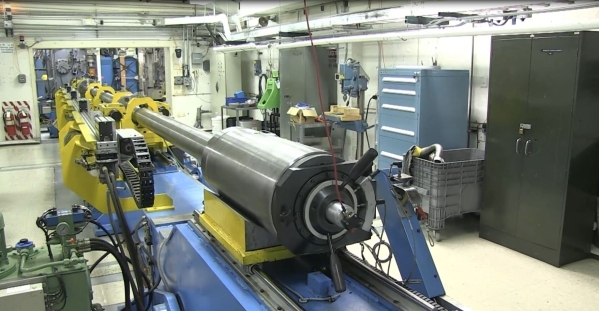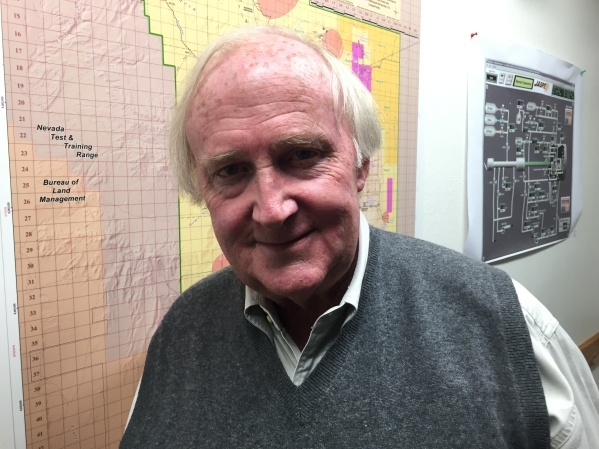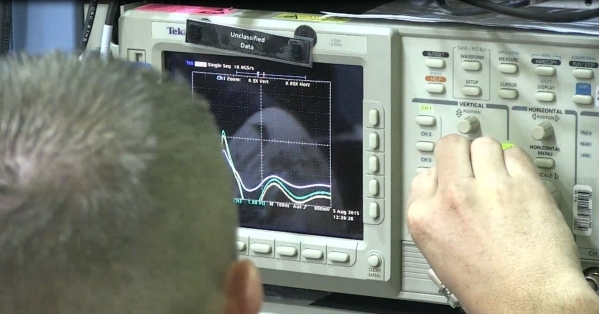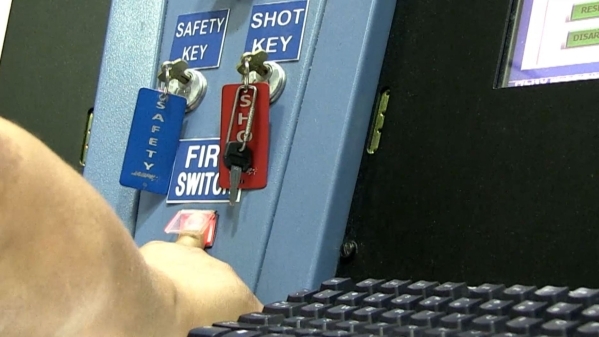Physicists test warhead material at superhero speed at Nevada site — VIDEO
MERCURY — Chief scientist Neil Holmes doesn't wear a red cape or display a big "S" on his chest, but it goes without saying that the feats his team must do rise to the level of Superman.
On Tuesday, the team fired a copper-tipped projectile faster than a speeding bullet at a target in a vacuum chamber using a 55-foot-long gas gun known as JASPER. The projectile reached a speed of 11,500 miles per hour before it slammed into a piece of aluminum meant to simulate the business end of a nuclear warhead.
And this was just a rehearsal to calibrate their instruments for the main event: an upcoming experiment targeting actual plutonium — the real stuff used to power nuclear chain reactions — to see how it behaves at high temperatures and pressures.
"It will reach thousands of degrees and be compressed by a factor of two," said Holmes, 66, whose team from California's Lawrence Livermore National Laboratory and National Securities Technologies operates the JASPER gun in a remote part of the Nevada National Security Site, 80 miles northwest of Las Vegas.
"It's like taking an orange and squeezing it the size of a lemon," he said.
It's been 20 years since the Department of Energy launched the science-based stockpile stewardship program to certify that U.S. nuclear weapons are safe and reliable in the absence of full-scale tests.
Those historic below-ground blasts at the former Nevada Test Site once swayed skyscrapers in Las Vegas, but they were put on hold indefinitely in 1992 by nuclear arms treaties and stockpile-reduction measures at the end of the Cold War.
Now scientists rely on experiments using the JASPER gun and other physics tools to meet annual arms certification requirements.
Other tools include laser fusion experiments at Livermore's National Ignition Facility, and subcritical experiments conducted down hole in deep chambers at the Nevada National Security Site.
Subcritical experiments involve gram-size amounts of plutonium that are shocked with high explosives but are too small to erupt into nuclear chain reactions like those that occur when atomic bombs explode.
Tuesday's JASPER calibration experiment was the 135th "shot," as scientists call them, since the gun went online on March 19, 2001. Of those, 60 were "hot shots" using radioactive metal targets, also known as actinides, made from elements low down on the Periodic Table, including uranium and plutonium.
JASPER stands for Joint Actinide Shock Physics Experimental Research. It is a two-stage gas gun that uses gun powder to fire a plastic-wrapped "piston" through a "pump tube" filled with hydrogen, helium or nitrogen. The hot gases propel the piston through a cone-shaped end of the first tube, rupturing a valve that, with the force of compressed hydrogen gas, sends a projectile of plastic-molded copper, aluminum or tantalum down a narrow "barrel" at a very high rate of speed.
JASPER can fire 1 1/2-inch-long, 1 1/8-inch diameter projectiles at 18,000 mph — about 10 times faster than a bullet from a standard hunting rifle.
The target is inside a vacuum chamber equipped with sensors that transmit data to instruments in a control room adjacent to the gas gun. Signals from x-rays, lasers, electrical shorting pins and photo tubes are used to measure speed, shock waves and brightness as the target breaks apart.
The readings are sent over a classified, encrypted network for scientists in Livermore, Calif., to analyze.
Albert Lee, JASPER program manager from the Livermore lab, said data produced by the gun must be very precise to ensure the reliability of computer models used to predict how plutonium behaves as it ages in the stockpile. Scientists can then forecast what will happen when a nuclear weapon detonates under certain circumstances.
Holmes, a condensed matter physicist, said the sensors have "amazing accuracy." The speed of the shock wave is measured by electrical shorting pins that are accurate down to less than a billionth of a second.
Inside the control room Tuesday, the team went through an elaborate checklist until "all systems good to go" was announced to members wearing head-sets to communicate.
Then a horn sounded, and the final "three-two-one" count was made. A split second after the "fire" button was pushed, the projectile slammed into the target with a slap sound like someone dropping a dictionary on a tile floor.
"Shot time thirteen zero one-forty," the controller announced.
The team seemed pleased with the outcome.
"So far it looks like a classic, successful experiment," Holmes said.
Contact Keith Rogers at krogers@reviewjournal.com or 702-383-0308. Find him on Twitter: @KeithRogers2




















